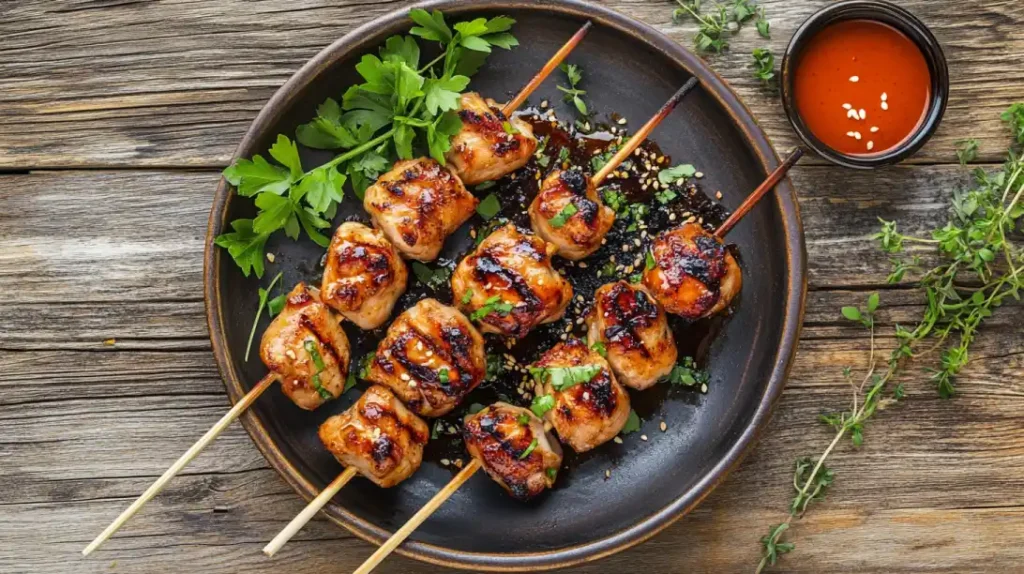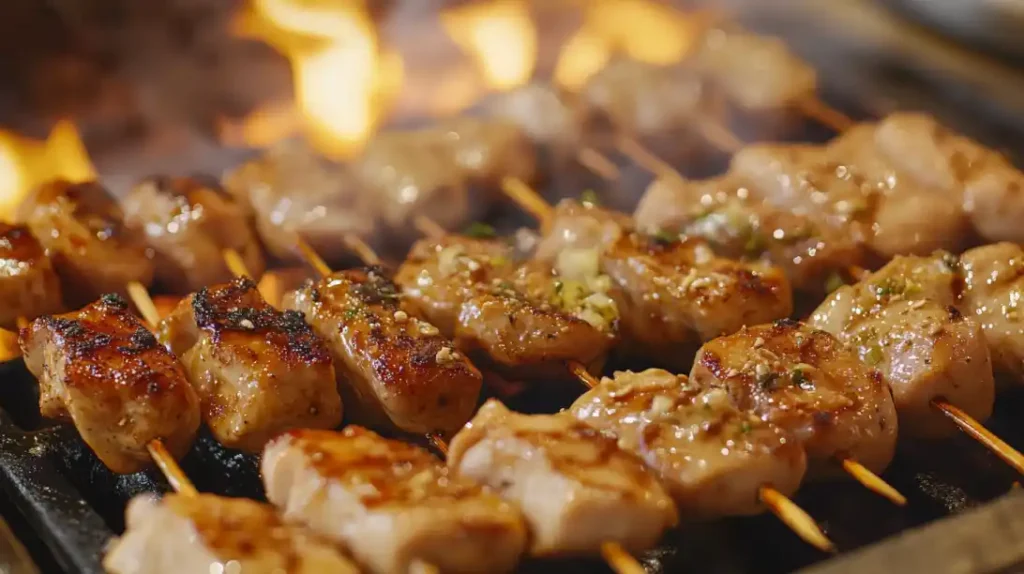
Imagine biting into a piece of chicken so tender and flavorful that it makes you wonder, “Why doesn’t all chicken taste this good?” Meet Jidori chicken—the Beyoncé of poultry. This isn’t your average supermarket bird. It’s a premium, free-range chicken breed from Japan that’s been stealing the spotlight in kitchens worldwide. But what makes it so special? Buckle up, because we’re diving into the juicy world of Jidori chicken, from its ancient roots to why it’s worth every penny!
“Jidori isn’t just chicken—it’s a cultural experience on a plate.” – Chef Hiroshi Yamamoto
Table of Contents
What is Jidori Chicken?
Definition and Origins of Jidori Chicken
The word “Jidori” (地鶏) literally means “local chicken” in Japanese. But don’t let the simple name fool you! These birds are the VIPs of the poultry world. 🐓 Originating in Japan over 1,000 years ago, Jidori chickens are bred using strict standards: they must be raised for at least 140 days (vs. 40 days for factory-farmed chickens) and roam freely in open spaces. Think of them as the chickens that do yoga and eat organic—pure zen!
How Jidori Differs from Regular Chicken
Let’s play a quick game: Spot the Difference. Regular chickens? They’re like fast food—raised quickly, fed cheap grains, and packed into tight coops. Jidori? They’re the slow-cooked, farm-to-table alternative. Here’s the breakdown:
- 🕒 Time: Jidori chickens grow 3x slower than industrial breeds.
- 🌾 Diet: They feast on natural grains, veggies, and even bugs (gourmet snacks for chickens!).
- 🏞️ Lifestyle: Free-range living = less stress, more flavor.
The result? Meat that’s firmer, richer, and packed with umami—the savory “fifth taste” that makes your taste buds sing. 🎶
The History and Cultural Significance of Jidori Chicken
Jidori’s Roots in Japanese Tradition
Picture ancient Japan: samurais, tea ceremonies, and… chickens? Yep! Jidori chickens were first bred in the Edo period (1603–1868) as a delicacy for nobility. These birds were so prized that farmers treated them like royalty—giving them spacious coops and top-notch feed. 🏯 Fun fact: Some Jidori breeds, like the Hinai-jidori, are designated as a “National Natural Treasure” in Japan!
The Role of Jidori in Japanese Cuisine
Ever had yakitori (grilled chicken skewers) that made you close your eyes and sigh? That’s Jidori magic. In Japan, this chicken stars in iconic dishes like:
- 🍢 Yakitori: Charcoal-grilled skewers with crispy skin and smoky flavor.
- 🍲 Oyakodon: A comforting rice bowl with tender chicken and egg.
- 🍜 Ramen: Jidori broth is richer than a billionaire’s bank account.
“Using Jidori is like cooking with a flavor amplifier—it turns simple dishes into masterpieces.” – Tokyo Chef Akira Matsui
Key Characteristics of Jidori Chicken
Appearance and Breeding Standards
Jidori chickens aren’t winning any beauty pageants (they’re leaner and smaller than factory birds), but their flavor is Oscar-worthy. 🏆 To earn the “Jidori” label in Japan, farms must follow rules stricter than a school dress code:
| Standard | Requirement |
|---|---|
| Age at Slaughter | ≥140 days |
| Diet | 100% natural, no additives |
| Space | Minimum 1 sq. meter per bird |
Flavor Profile and Texture
Biting into Jidori chicken is like sinking your teeth into a cloud—if clouds were savory and juicy. 🍗 The meat has a deep, almost gamey richness, while the skin crisps up like potato chips. And because the birds exercise, their meat has a firmer texture—no mushy bites here!
Nutritional Benefits of Jidori Chicken

Health Advantages Over Conventional Chicken
Jidori isn’t just a treat for your taste buds—it’s a win for your body too! Studies show free-range chickens have:
- 🥩 50% more omega-3s (good for your brain!).
- 💪 Higher protein content (muscle fuel!).
- 🚫 No antibiotics or hormones (clean eating!).
| Nutrient | Jidori Chicken | Regular Chicken |
|---|---|---|
| Calories | 165 | 145 |
| Protein | 31g | 27g |
| Fat | 3.5g | 8g |
Why Jidori is a Superior Protein Choice
Think of Jidori as the Tesla of proteins—sleek, efficient, and environmentally friendly. Its lean meat packs more nutrients per bite, and since the birds are stress-free, their meat lacks the lactic acid that makes factory chicken taste bland. Win-win!
🔥 Pro Tip: Save the bones! Jidori broth is liquid gold for soups and sauces.
“Eating Jidori is like giving your body a hug from the inside.” – Nutritionist Dr. Emily Sato
Common Problems When Cooking Jidori Chicken (and Solutions!) 🛠️

Problem #1: Limited Availability Outside Japan
Let’s face it: Jidori chicken isn’t exactly hanging out next to the frozen nuggets at your local grocery store. 🛒 If you’re outside Japan, finding it can feel like searching for a unicorn. But don’t panic! Here’s how to track it down:
Solution: Where to Source Authentic Jidori Chicken Globally
- 🌍 Specialty Butchers: Check Japanese or high-end butcher shops—they often import Jidori.
- 🛩️ Online Retailers: Websites like WagyuShop or Crowd Cow ship frozen Jidori worldwide.
- 🍣 Japanese Restaurants: Some sell raw Jidori meat if you ask nicely (and promise to tag them on Instagram).

“Jidori’s scarcity is part of its charm. Treat it like a rare gem—worth the hunt!” – Butcher Kenji Sato
Problem #2: Overcooking Due to Leaner Meat
Jidori chicken is like that friend who’s secretly sensitive—it doesn’t handle tough love. 🥺 Because it’s leaner, overcooking turns it dry faster than a desert. But fear not! Here’s the fix:
Solution: Best Cooking Techniques for Juicy Results
- 🔥 Low and Slow: Roast at 325°F (163°C) with a meat thermometer (aim for 165°F internal temp).
- 💦 Brine It: Soak in saltwater for 2 hours before cooking to lock in moisture.
- 🍯 Marinate Smart: Use olive oil, lemon, or yogurt-based marinades to tenderize.
👉 Pro Tip: Jidori thighs > breasts. Dark meat stays juicier, even if you forget the timer!
Problem #3: Higher Cost Compared to Regular Chicken
Yes, Jidori costs more—like comparing a sports car to a bicycle. 🚴♂️➡️🏎️ But you can stretch every dollar (or yen) with these tricks:
Solution: Maximizing Value Through Nose-to-Tail Cooking
- 🍗 Save the Bones: Simmer scraps into broth for ramen or risotto.
- 🥘 One-Bird Meals: Use breasts for stir-fry, thighs for curry, and wings for appetizers.
- 🛒 Buy in Bulk: Split a whole bird with friends—it’s cheaper per pound!
| Chicken Type | Average Price |
|---|---|
| Regular Chicken | $3-$5 |
| Jidori Chicken | $10-$15 |
Traditional and Modern Culinary Uses of Jidori Chicken 🍴
Classic Japanese Dishes: Yakitori, Oyakodon, and More
Jidori chicken is the MVP of Japanese comfort food. Here’s how to rock it like a Tokyo street chef:
- 🍢 Yakitori: Skewer bite-sized pieces, grill over charcoal, and brush with tare (sweet soy glaze).
- 🍚 Oyakodon (“Parent-and-Child Bowl”): Simmer chicken and egg in dashi broth, then pour over rice. It’s like a warm hug!
- 🍜 Ramen: Boil Jidori bones for 12+ hours to create a broth so rich, it’ll make your spoon stand up.
“Yakitori without Jidori is like popcorn without butter—just sad.” – Street Vendor Yuki Tanaka
Fusion Recipes: Jidori Tacos, Salads, and Sous Vide Creations
Why stick to tradition? Jidori’s versatility shines in global mashups:
- 🌮 Jidori Tacos: Shred smoked Jidori, add pickled veggies, and drizzle with spicy mayo.
- 🥗 Herb Salad: Toss grilled Jidori slices with arugula, mango, and yuzu dressing.
- 🔪 Sous Vide: Cook breasts at 145°F (63°C) for 2 hours—butter-knife tender!
Grilling, Roasting, and Broiling Tips for Perfect Results
Jidori loves heat, but treat it right:
- 🔥 Grilling: Keep the skin on! It crisps up like bacon and seals in juices.
- 🍗 Roasting: Place the bird on a bed of veggies (carrots, onions) to infuse flavor.
- 🌡️ Broiling: Finish under the broiler for 2 minutes to golden perfection.
| Cut | Grilling | Roasting |
|---|---|---|
| Breast | 6-8 mins/side | 25-30 mins |
| Thigh | 8-10 mins/side | 35-40 mins |
How to Buy and Store Jidori Chicken 🛒❄️
Identifying High-Quality Jidori: Labels and Certifications
Not all “Jidori” is legit! Look for:
- 🏷️ Japanese Certification: Labels like “Japan Jidori Association Approved.”
- 📍 Origin: Authentic Jidori is bred in Japan (e.g., Kagoshima or Miyazaki prefectures).
- 📦 Packaging: Vacuum-sealed with minimal blood—a sign of freshness.
Proper Storage Methods to Preserve Freshness
- ❄️ Freezing: Wrap tightly in foil; use within 3 months.
- 🌡️ Fridge: Store raw Jidori on the bottom shelf (to avoid drips) and use within 2 days.
- 🍲 Cooked Leftovers: Keep in airtight containers for up to 3 days.
“Treat Jidori like a VIP guest—store it properly, and it’ll reward you!” – Food Safety Expert Maria Gomez
Sustainability and Ethical Farming Practices 🌱🐔
How Jidori Farming Supports Environmental Health
Ever wonder why Jidori chickens prance around like they own the farm? It’s because they’re raised in harmony with nature! 🌞 Unlike industrial farms that cram thousands of birds into warehouses, Jidori farms are like eco-resorts for chickens. Here’s the scoop:
- 🌳 Land Use: Jidori chickens roam freely, reducing soil erosion and promoting natural fertilization.
- 💧 Water Efficiency: Pasture-based systems use 30% less water than factory farms.
- 🌍 Carbon Footprint: Less machinery and transportation mean fewer emissions—Mother Earth approves!
“Raising Jidori isn’t just farming; it’s stewardship. We work with the land, not against it.” – Farmer Aiko Nakamura
| Aspect | Jidori | Conventional |
|---|---|---|
| Space per Bird | 1+ sq. meter | Cage-free? More like cage-crammed! |
| Feed Type | Non-GMO, local grains | Cheap, processed pellets |
| Lifespan | 140+ days | 40 days (speed-grown!) |
Ethical Treatment and Free-Range Standards
Jidori chickens live the #BestLife—no stress, no cages, just sunshine and snacks. 🍃 In Japan, farms must pass audits to ensure:
- ✅ No antibiotics or hormones (happy birds = healthy birds).
- ✅ Outdoor access daily (they even get rainy days off!).
- ✅ Humane slaughter practices (respect from start to finish).
Raising Jidori Chickens: Challenges and Best Practices
Common Challenges for Farmers
Farming Jidori isn’t all zen gardens and smooth sailing. Here’s what keeps farmers up at night:
- ⏳ Slow Growth: Waiting 140 days tests patience (and budgets!).
- 🦊 Predators: Foxes and hawks think Jidori is *their* gourmet meal.
- 💸 High Costs: Premium feed + land = $$$.
Tips for Sustainable Jidori Poultry Farming
- 🤝 Co-Op Farming: Share resources with neighbors to cut costs.
- 🌾 Rotational Grazing: Move flocks to fresh pastures to keep soil healthy.
- 📱 Tech Help: Use apps to monitor bird health and track feed efficiency.
“You don’t raise Jidori—you collaborate with them. They teach you patience.” – Farmer Kenji Ito
Debunking Myths About Jidori Chicken 🕵️♂️
Myth #1: “Jidori is Just a Marketing Term”
Nope! In Japan, “Jidori” is legally protected—like Champagne in France. To use the label, farms must meet strict guidelines (see table below). It’s not just a fancy sticker!
| Criteria | Standard |
|---|---|
| Breeds | Must be native Japanese species |
| Raising Period | Minimum 140 days |
| Feed | 100% natural, no additives |
Myth #2: “All Jidori Tastes the Same”
Wrong again! Jidori flavor varies like wine regions. For example:
- 🍗 Hinai-jidori (Akita Prefecture): Rich, buttery, with a hint of sweetness.
- 🔥 Satsuma-jidori (Kagoshima): Bold, smoky, perfect for grilling.
“Each Jidori breed tells a story of its homeland. Taste the terroir!” – Food Critic Yumi Ishikawa
Expert Tips for Cooking Jidori Chicken 👩🍳🔪
Chef-Recommended Seasoning and Marinades
Jidori’s flavor is a superstar—don’t drown it in sauce! Keep it simple:
- 🧂 Shio Koji: Fermented rice marinade for umami explosion.
- 🍋 Yuzu & Garlic: Bright citrus + punchy garlic = magic.
- 🍯 Miso Paste: Smear on thighs before grilling—caramelized goodness!
Avoiding Common Home-Cooking Mistakes
- 🚫 Over-Marinating: 2 hours max! Acid breaks down tender meat.
- 🚫 High Heat: Medium flames prevent rubbery texture.
- 🚫 Wasting Skin: Crisp it up—it’s the best part!
The Future of Jidori Chicken in Global Cuisine 🌐🍲
Growing Popularity in Western Markets
From NYC to Paris, chefs are swapping regular chicken for Jidori. Why? Foodies crave authenticity! 🧑🍳 Trendy spots like Jidoriya in LA serve Jidori yakitori bowls that sell out daily.
Innovations in Jidori-Based Products
- 🥡 Meal Kits: Pre-marinated Jidori with step-by-step recipes.
- 🍟 Snacks: Jidori jerky—high-protein, low-guilt munching.
- 🍗 Fast Casual: Jidori nuggets (yes, they’re a thing!).
“Jidori isn’t a trend—it’s the future of mindful eating.” – Chef Marco Perez
Frequently Asked Questions (FAQs) ❓
What does Jidori mean in Japanese?
“Jidori” (地鶏) means “local chicken,” referring to free-range, heritage breeds raised under strict standards.
How do you pronounce jidori chicken?
Pronounced “jee-doh-ree” (地鶏), with equal stress on all syllables—like “jee-door-ee” without the “w.”
Does jidori chicken taste different?
Yes! Richer, firmer, and packed with umami—think savory depth vs. bland factory-farmed chicken.
What is a Jidori egg?
Eggs from Jidori hens: smaller, with vibrant orange yolks prized in ramen and desserts for ultra-creamy texture.
Conclusion: Why Jidori Chicken Deserves a Spot in Your Kitchen 🏆
Let’s be real: Jidori isn’t cheap, but it’s an investment in flavor, ethics, and your health. Whether you’re grilling skewers or simmering broth, this chicken elevates every bite. Ready to taste the difference? Your palate (and the planet) will thank you. 🙌
Jidori Chicken with Soy-Ginger Glaze
Ingredients
- 4 Jidori chicken thighs bone-in, skin-on
- Substitute: Free-range organic chicken if Jidori isn’t available
Marinade:
- ¼ cup soy sauce
- 2 tbsp sake or dry white wine
- 2 tbsp mirin or 1 tbsp honey + 1 tbsp rice vinegar
- 1 tbsp grated ginger
- 2 garlic cloves minced
- 1 tbsp brown sugar
- Garnish: Toasted sesame seeds sliced scallions
Instructions
Marinate the Chicken:
- In a bowl, mix soy sauce, sake, mirin, ginger, garlic, and brown sugar.
- Pat chicken dry and score the skin lightly (to help absorb flavor).
- Place chicken in a resealable bag or dish, pour marinade over, and refrigerate for 2–4 hours (up to overnight).
Prep Cooking Method:
- Grill Option: Preheat to medium-high (375°F/190°C). Oil the grates.
- Oven Option: Preheat to 400°F (200°C). Use a wire rack on a baking sheet.
Cook the Chicken:
- Remove chicken from marinade (reserve marinade). Let sit at room temp for 15 mins.
- Grill: Cook skin-side down for 6–8 mins until charred. Flip and cook 10–12 mins more.
- Oven: Roast skin-side up for 25–30 mins, until internal temp reaches 165°F (74°C).
Make the Glaze:
- Simmer reserved marinade in a saucepan for 5–7 mins until thickened. Brush onto chicken during the last 5 mins of cooking.
Rest & Serve:
- Let chicken rest 5 mins. Garnish with sesame seeds and scallions.
- Serve with steamed rice, pickled vegetables, and miso soup.
Notes
Tips for Success:
- Don’t Overcook: Jidori is leaner than regular chicken—monitor internal temp.
- Crispy Skin: Start cooking skin-side down for maximum crispiness.
- Gluten-Free: Use tamari instead of soy sauce.

